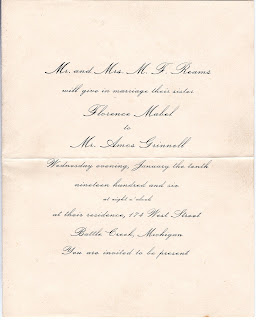| Postcard from the Great War, owned by David B. Johnson |
In a little over a week from now our nation will be commemorating
the centennial of the US entering into the Great War, now known as the First
World War. While the war raged in
Europe since 1914 the United States, led by President Woodrow Wilson remained
in a neutral position for several years.
Following the German U-boats sinking of several American vessels in the
Atlantic, neutrality was no longer possible and on April 2, 1917 Wilson addressed
Congress and asked for a Declaration of War against Germany. Upon the affirmative votes in the Senate
followed by the House of Representatives, the United States went to war on
April 6, 1917. The war continued to rage
until November 11, 1918, which was known as Armistice Day for generations and
is now celebrated at Veteran’s Day here in the US. Ultimately, 4.7 million American’s would
serve in the Army and Navy during the war with approximately 120,000 killed in
action.
| David B. Johnson, 1918 USS Georgia |
Serving in the armed forces was a hard decision in many
parts of the United States, given that there were large numbers of American’s
of German descent living in both urban and rural communities, they often experienced divided loyalties. The maternal side of my family lived in one
of those communities where the German language was still being taught alongside
English in many of the rural one-roomed school houses in northeastern Jackson
County, Michigan. However, patriotism ran deep in the Johnson family and
they would send two of their son’s off to fight for the US and the Allies.
| Dave's New Testament during his time in the Navy |
David and Nina Johnson lived in Leoni Township and by time
the US entered the war they had six children at home. Two would go off to war. First, their eldest son, John Vernon Johnson (1898-1970)
would serve in Battery B of the 21st Field Artillery Unit, which had
just recently been organized. John would
attain the rank of Sergeant by the time he was discharged and sent back home. Then their second son David Benjamin Johnson
(1900-1967) would volunteer. Although
Dave was only seventeen at the time, he lied about his age and stated that he
was born a year earlier. David B. Johnson would enlist in the US Navy on 22 March 1918
for 4 years of service in Cincinnati, Ohio.
A description of him at the time indicates he was 5 foot 9 inches tall, weight
175 lbs., had blue eyes, brown hair, and a Rudy complexion. He was then sent to the Great Lakes Naval
Training Station, located just north of Chicago and then to the Naval
Operations Base at Norfolk, Virginia where on 24 May 1918 he was assigned about
the USS Georgia, a Virginia-class
battleship that was constructed at the Bath Iron Works in Maine. The USS
Georgia was commissioned in 1906.
During the war the Georgia
would serve in the Atlantic Fleet mainly as a convoy escort for the many
vessels that were transporting American Troops to France. Dave would be ranked as a Firemen 2nd
Class while on the Georgia.
Brest, France was one of the main ports of entries and exits
for the American Troops. We know that
Dave was on the USS Georgia in Brest
on at least two occasions, December, 1918 and June, 1919. His assignment on the USS Georgia ended on June 28, 1919.
Following his service on the Georgia,
he would be assigned to the USS Florida
as his final vessel during his service, but this was a short 2 month assignment
and it isn’t known to me what activity he may have been engaged during that
time. Ultimately, Dave was discharged
from the US Navy on 7 August 1919 at the Naval Demobilization Center in
Pittsburgh, PA, where he was given $16.55 for his transportation back home to
Jackson, Michigan.
| Souvenir post card from France, 1918 |
While no correspondence survives from the time Dave served in
the Navy, we are fortunate that there are a number of photographs and official
documents that he kept to from his war service and they help us peak into his
world as a Navy man. Once Dave returned
home, we know that he went back to work as a farm hand and also worked for
short periods of time on the Michigan Central Railroad. But work was difficult to find following the war
and by 1922, Dave re-enlisted in the service, this time into the U. S. Army,
where he would be stationed at the Schofield Barracks in Hawaii for several
years.
We here in the United States are very fortunate that our service members saw such a brief period of the Great War. Other members of the Allies, and also those of the Central Powers, experienced huge loss of lives and many soldiers that did return home were diagnosed with "shell shock," what we know of today as "post traumatic stress syndrome." So many peoples lives were devastated during this conflict, both physically and emotionally.
John and David Johnson were fortunate to be able to return home to their families and to adjust to life after war with few major problems. We are all thankful because they both established new generations of our family. Thank you for your willingness to serve and know that we remember!
| David B. Johnson's Discharge Papers, 1919 |





